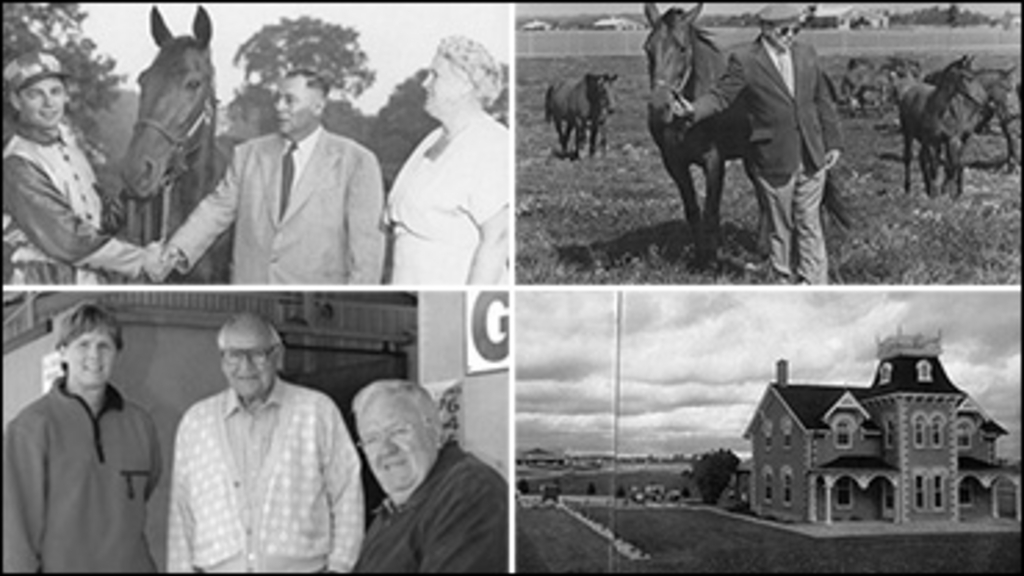
 In this week's 'Rewind' column Robert Smith recalls the Armbro name, undoubtedly the best known and respected name ever associated with Canadian harness racing.
In this week's 'Rewind' column Robert Smith recalls the Armbro name, undoubtedly the best known and respected name ever associated with Canadian harness racing.
In this week's Rewind column Robert Smith recalls the Armbro name, undoubtedly the best known and respected name ever associated with Canadian harness racing. His story traces the origins of the Armbro name and discusses a bit of the tremendous influence that two generations of the Armstrong family have contributed to the sport.
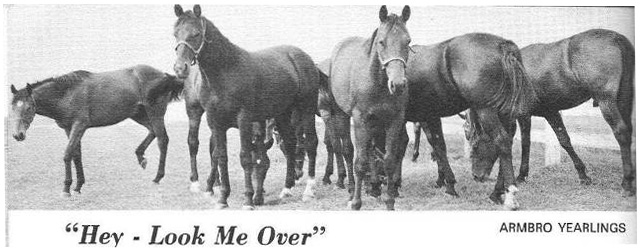
Nearly 70 years ago a couple of enterprising brothers decided to venture into the world of harness racing, having dabbled a bit previously with the thoroughbreds. Just what their dreams and aspirations were in the beginning I am not certain. What I do know is that the brothers Elgin and Ted Armstrong wrote the book on excellence in our sport over the next several decades.
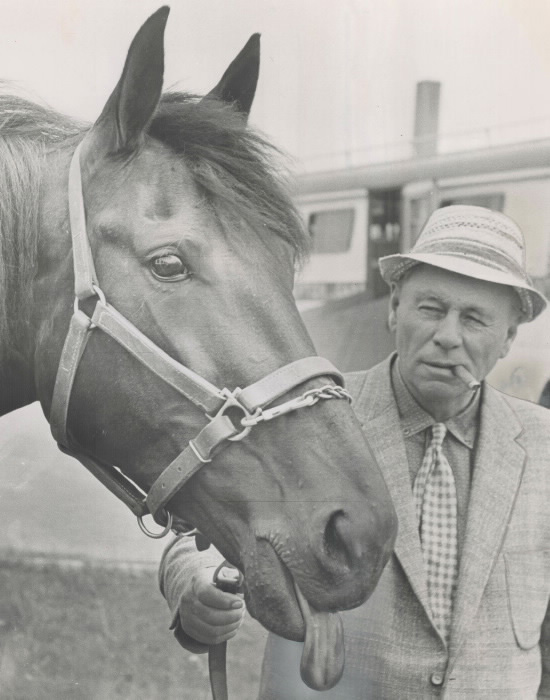
Elgin Armstrong co-founder and owner of the famed Armbro operation appears in a 1960's photo with Armbro Flight one of their early stars. The daughter of Helicopter was a standout on the track and later joined their broodmare band
By the 1960's Elgin's son Charlie also became involved; he added even more class and integrity. From a humble beginning, their vision carried them to a place in history that positions them in very special territory. In 2004 the Armstrong dynasty closed out its long and successful existence, but the Armbro name will forever be etched in the history of Canadian Harness Racing.
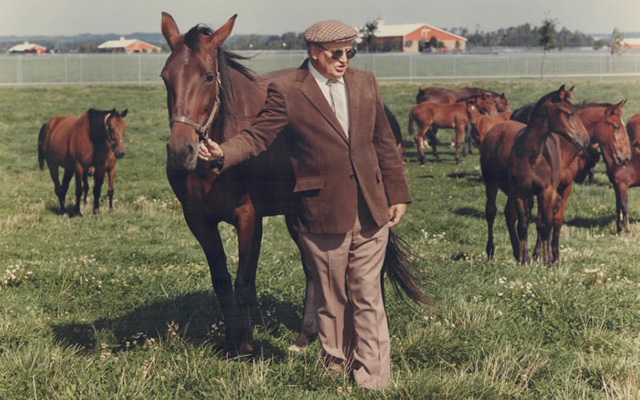
Charlie Armstrong pays a visit to a group of Armbro farm residents in this 1980's photo. Visible in the background are several of the structures that were part of the new complex built in 1978.
I have chosen to display a few old photos and ads that tell a small portion of the Armstrong history and its resulting success. A story of this magnitude is not told in one simple episode, but rather could fill many. If anyone in the reading audience has something relevant to add please do so as it will only enhance the story.
Over the years the Armstrong operation allied itself with the most proficient people in the industry. From their earliest days, they dealt with the top trainers and drivers in the business. Starting with Delvin Miller, they eventually cultivated associations and working relationships with many other top people. The names of Joe O'Brien, Billy Haughton, Jack and John Kopas, Bill Wellwood and of course the ill- fated Glen Garnsey, who died so tragically at the height of his career was a mainstay in the racing operation. In the Canadian portion of the racing setup, one man was associated with the Armstrong operation for a huge portion of his professional career and that was Harold McKinley.
In 1953 as virtual newcomers to the sport, the Armstrong Brothers pulled off what has to be one of the great coups in the sport's history. They captured the prestigious Hambletonian Stake at DuQuoin, Illinois with the filly Helicopter, a filly they had purchased for a mere $7,500. After owning just a "handful" of horses they won the biggest race in the sport on their first try, a victory that would net them $63,126 for a single day's work, a record to that point in time. Despite the passage of almost 66 years, it is still a highlight that is spoken of whenever harness racing history is discussed.
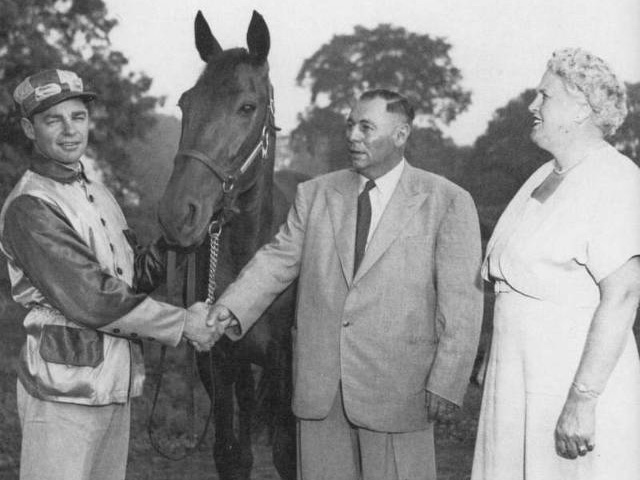
Elgin Armstrong and his wife Victoria congratulate Harry Harvey, the 29-year-old driver of Helicopter, following their stunning victory in the 1953 Hambletonian. The filly was victorious in a field of 20 three-year-old trotters on that memorable day at Goshen. (Harness Horse)
Dr. Glen Brown joined the Armstrong family operation in 1958 and remained for the duration of its existence. He saw it grow from a small operation to a huge enterprise that eventually gained world-class status. A number of other veterinarians including Dr. John McKnight and Dr. Moira Gunn were also integral parts of the world class facility. Numerous other employees staffed the operation; many serving with lengthy careers. The farm was generally acknowledged as the Standardbred breeding capital of Canada.
In 1960 the Armstrong Farm sent its first crop of yearlings to auction. A group of 15 youngsters brought a total of just over $68,000 for an average of $4,563. Just nine years later in 1969, they sold 41 head for $365,200 - an average of $8,907. In later years the numbers continued to escalate and were always at or near the top of the annual statistics.
I recently asked Dr. Brown just how the naming of the Armbro foals began and he graciously gave me some of the background that went into the annual naming process. Here are some excerpts from his letter:
"The ARMBRO came of course as an abbreviation of Armstrong Brothers. I started with Armstrong's in 1958 and the yearling crop on the ground at that time included Armbro Adanac. So the first in the alpha sequence were foals of 1957. They had a few prior foals not in the alpha sequence, such as Armbro Express, a pretty good free for aller back in those days. Obviously, the whole process had been set in place before my arrival.
"The employees were asked to submit names, and often suggested which foal it should be affixed to. The final choice was made in the early days by myself and later Dr. Gunn. I never was really that interested in the names -- I always believed a good horse had a good name. Their names were not used on the farm; they were always 'so and so's foal'. Often most saw the name for the first time when the sale catalogues were published.
"We were able to retain sole rights to the name by registering it with the USTA, and we retained that right as long as we kept breeding.
"The order was reversed in a few cases - Governor Armbro (Kentucky Futurity winner) - sounded better than the other way around. The CSHS would not let you use the Armbro prefix unless we were the breeder - not so in the U.S. There were a few cases where we bought pregnant mares and those were registered first with the U.S.T.A. Then we got C.S.H.S. papers off the U.S. certificate. I'm not sure it made a lot of sense and wasn't done very often."
The Armstrong Brothers life story is an extremely interesting tale. They were born on a farm south of Brampton. In 1929 at the dawn of the Depression they started a business known as Armstrong Brothers Company. With just a few dump trucks and a small employee base, they performed simple construction projects in the Peel County area. In time the firm grew by leaps and bounds and their scope of activity was almost endless. No job was too large for them and at one time they constructed a 100 mile strip of Highway 401 !! Their projects carried them to many parts of the globe, but Ontario was always home. With brother Ted acknowledged as "the engineering genius" of the two, the firm constantly improved in every facet of its operation. They were among the first to use computers to speed their processes.
As the years changed they too increased their business scope. They were involved with building the Welland Canal, airport runways and other massive projects. In the late 1940's, they purchased a 95-acre farm at Brampton. It was a huge source of gravel which led to yet another enterprise and also paved the way to their horse involvement. Their land holdings later included over 1,000 acres devoted to the horse interests.
Despite their rise to prominence and the enormous growth the enterprise experienced over the years, the ethics code of their business never changed. They treated everyone with the utmost respect and continued to remember their old friends and business colleagues as they had done as a fledgling operation. Virtually everything they did was aimed at contributing to the growth and wellness of the sport and business of harness racing in general and particularly in Canada. The word "Class" could be attached to anything the Armstrongs said or did, and it was always done with sincerity, good taste and caring.
In the early years the farm was located on No. 7 Hwy just west of No. 10 in the City of Brampton. That site contained around 300 acres with adjoining land leased from Elgin's son Charlie plus another 100-acre site on the edge of Caledon used as a yearling farm (Armbro Flight was raised there). In 1978 when the move to Inglewood was made, the Armstrongs put together approximately 1,100 acres which was the peak of their operation and remained so for many years. Much of that acquisition was put together by Elgin Armstrong and of course involved purchasing several farms. A number of employees lived on various farms.
The two founding fathers passed away in 1977 and 1978 and unfortunately did not see the new ultra-modern operation completed although they were both part of the original planning sessions. Dr. Brown did show Elgin through one of the barns during construction but he did not see the finished product. An interesting portion of the new land holdings known as the Smith House was saved and in fact is still standing and will undoubtedly continue to virtually forever. It is pictured below as it was in 1979 with a further description.
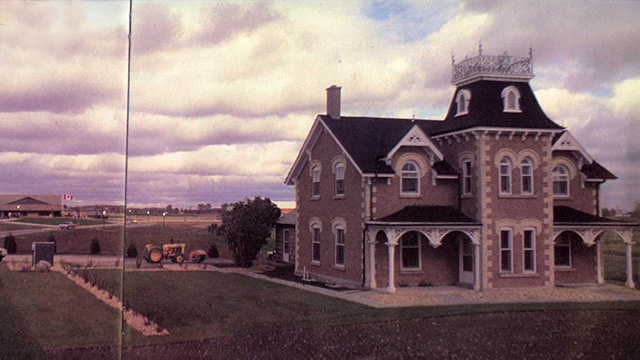
The Smith House designated as a historical structure has a long and interesting history. All of the barns, silos and related buildings standing at the new farm site when it was purchased were leveled. Only the farmhouse built in 1865 by John Smith, an auctioneer, farmer and MPP for Peel County in the mid-1880's was saved and restored to be a guest house. For many years it served as the front entrance view of the new farm which was built from scratch (Hoof Beats photo)
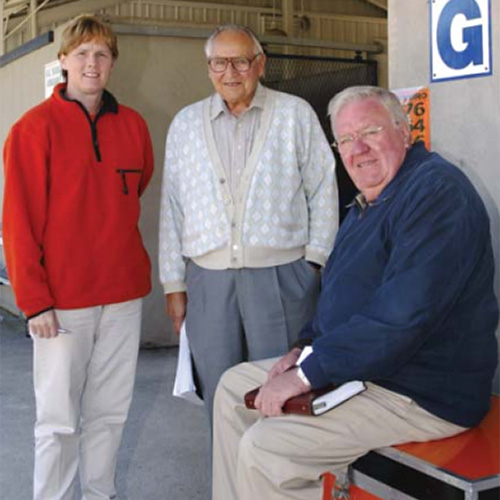
Charlie Armstrong, son of founder Elgin Armstrong (center) is shown at the Harrisburg sale a number of years ago flanked by Dr. Moira Gunn (left) and Dr. Glen Brown on the right. Dr. Brown is seated on an Armbro trunk bearing the familiar black and orange farm and company colours.
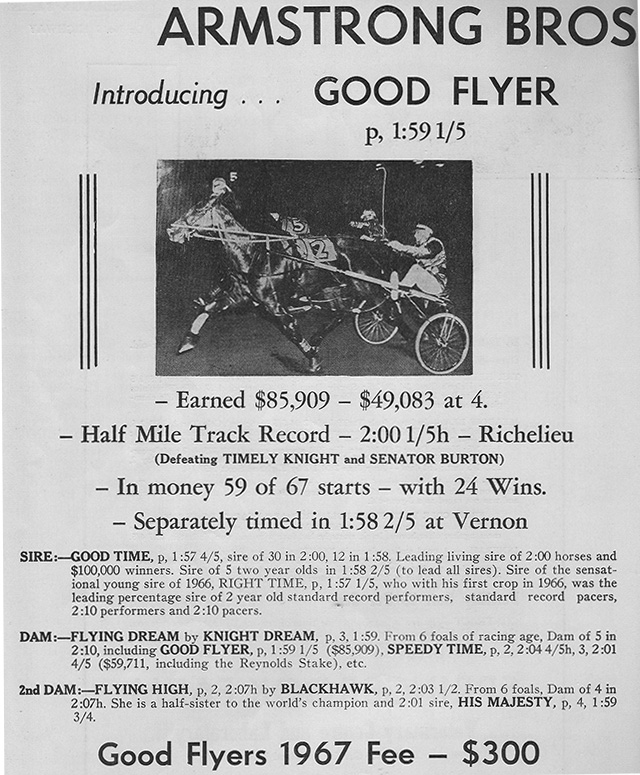
The above ad from the early days appeared in a 1967 edition of The Canadian Sportsman. It showed a new stallion Good Flyer who had just begun standing at the Farm at that time for a fee of $300 as was Armbro Express and Hoot Frost for the same fee. Rounding out the four stallion roster was Take Command at $200. Prices did escalate a bit in the years that followed.
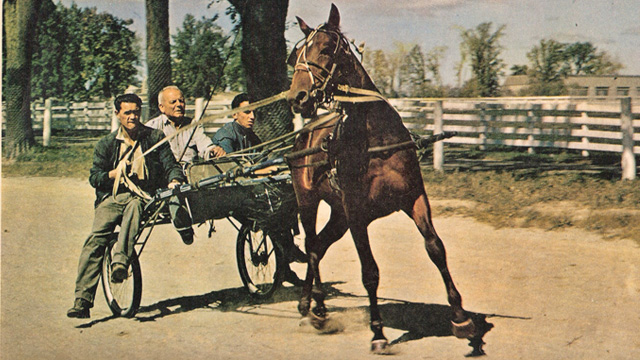
This 1965 scene shows three Armbro farm employees during an early yearling breaking exercise. Stew Howard is the driver, I do not have identities for the other two men.
I would like to gratefully acknowledge the assistance given to me by Dr. Glen Brown which was an immense help in compiling this story.


Smith Farm and House
John Smith was my 2nd Great grand Uncle. My grandfather was born (most likely) in the House pictured above in 1883. We have a lot of old photos of the family outside of the house on the grounds. My cousin Wendy now is in possession of many of those items, including, I believe the original seal for the land deed or something. My mum and I and Wendy (her first cousin) all came to see the house and we were fortunate that no one was in the house at the time and we were able to go inside and see the house, courtesy of the staff at the front office. Thank you!. Thank you for caring for it.
Working at the Armstrong’s
Working at the Armstrong’s (old farm) 69-71 was a great experience. I had the good fortune to work with and for top people. Dr. Glenn Brown, Dr John NcKnight, Larry Drysdale and many other guys, as we prepped the sales yearlings. Weekend duties often incorporated a visit from Mr Elgin and his chauffeur and a Cadillac drive around the huge paddocks, rum soaked cigars and all.
Through Armstrong’s I had the opportunity to work for Joe O’Brien in 1972, taking care of Melvins Woe as a 2yo.
For a young fella from the UK this will live forever.
I remember in the late
I remember in the late fifties the farm was called the A.B.C. Farms with Harold McKinley as their trainer. There colours were royal blue and white. The horses I remember they had were Captain Wright and Debora Frost both F.F.A. Pacers and Selka Song a F.F.A. Trotter. I think Captain Wright won the Canadian Pacing Derby and Selka Song won the Maple Leaf Trot. As I have said before I used to enjoy going over to the farm in September every year to look at yearlings. The place was spotless. I don’t know who was in charge of that. I am guessing it was Glen Brown or Charlie Armstrong. What a sad sad day it was for Standardbred horse racing the day they closed down.
Armbro always meant gold
Armbro always meant gold standard.